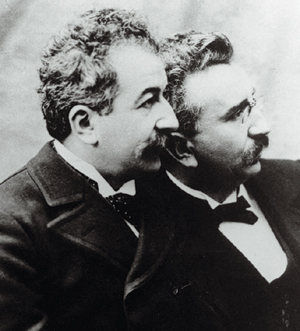
Lumiere brothers
The French
inventing team of brothers Auguste Lumière and Louis Lumière was
responsible for a number of practical improvements in photography and
motion pictures. Their work on colorphotography resulted in the
Autochrome process, which remained the preferred method of
creating color prints until the 1930s. They also applied their
technological talents to the new idea of motion picturephotography,
creating the first projection system that allowed a film to be seen by more
than one person at a time.

George Albert Smith

George Albert Smith
George Albert Smith was
a stage hypnotist, psychic, magic lantern lecturer,
astronomer, inventor, and one of the pioneers of British cinema, who is best
known for his controversial work with Edmund Gurney at the society of
physical research, his short-films from 1897-1903 which pioneered film editing
and close-ups, and his development of the first successful colour film process,
kinemacolour.
Cecil Hepworth
Cecil Hepworth survived in the film
business longer than any other British pioneer film-maker. His film-making
career began in 1899 when he converted a small house in Walton-on-Thames into a
studio. Twenty-five years later it would be the over-ambitious expansion of the
studio that would drive him out of business. In the course of his
career, Hepworth became one of the most respected, if not the most
dynamic, figures in British cinema.
Edwin Porter
Porter’s
skill with editing and methods of projection were used to great effect in some
of his earliest films. He combined documentary footage with his own footage in
films like 'The Execution of Czoyosz' (which he made with actor and set painter
George S. Fleming); in 'Life of an American Fireman' he adopted a documentary
style of filmmaking .

D.W. Griffith's
Griffith's was famous for
the film The Birth of a Nation made pioneering use of advanced camera
and narrative techniques, and its immense popularity set the stage for the
dominance of the Feature length film in the United States. The film has
been extremely controversial for its negative depiction of African Americans,
white Unionists and reconstruction, and its positive portrayal of
Slavery and the Ku klux klan. The film was widely criticized and subject
to boycotts by anti-racist organizations such as the NAACP. The film was not a
financial success but was praised by critics. Several of Griffith's later films
were also successful, but his high production, promotional, and
roadshow costs often made his ventures commercial failures. He is
generally considered one of the most important figures of early cinema for his
command of film techniques and expressive skills.
Lev Kuleshov
Lev Kuleshov was a
Russian director who used the editing technique known as the "Kuleshov
effect." Although editing innovations, such as crosscutting were used by
directors in Hollywood before him, Kuleshov was the first to use it in the
Soviet Russia. Openly pro-American and quietly anti-Soviet, he was driving a Ford
sports car amidst Soviet poverty and Stalin's purges, and remained a
controversial figure who joined the Soviet communist party and destroyed
archives of rare silent movies during his experiments, thus clearing way for
his own works.
Sergei Eisenstein
Eisenstein was a pioneer
in the use of montage, a specific use of film editing. He and his contemporary,
Lev kuleshov, two of the earliest film theorists, argued that montage was the
essence of the cinema. Eisenstein believed that editing could be used for
more than just expounding a scene or moment, through a "linkage" of
related images. Eisenstein felt the "collision" of shots could be
used to manipulate the emotions of the audience and create film metaphors. He
believed that an idea should be derived from the juxtaposition of two
independent shots, bringing an element of collage into film. He developed what
he called "methods of montage", starting from Metric,Rhythmic, Tonal, Overtone and Intellectual
Alfred Hitchcock
Hitchcock fashioned for
himself a distinctive and recognisable directorial style. He pioneered the use
of a camera made to move in a way that mimics a person's gaze, forcing viewers
to engage in a form of voyeurism. He framed shots to maximise anxiety,
fear, or empathy, and used innovative film editing.His stories frequently
feature fugitives on the run from the law alongside "icy blonde"
female characters. Many of Hitchcock's films have twist endings and
thrilling plots featuring depictions of violence, murder, and crime, although
many of the mysteries function as decoys or "MacGuffins" meant only
to serve thematic elements in the film and the extremely complex psychological
examinations of the characters. Hitchcock's films also borrow many themes from
psychoanalysis and feature strong sexual undertones. Through his cameo
appearance in his own films, interviews, film trailers, and the television
program of him. he then later became an icon in the film industry.
References








